This post may contain affiliate links. Please read our disclosure policy.
Whole30 Baked Salmon with sweet and spicy gochujang glaze. This easy and healthy Paleo Asian salmon recipe is moist, flavorful, and juicy, and only takes 15 minutes to bake! It’s like a mini upgrade to your favorite BBQ sauce with a Korean flair, smothered all over the salmon fillets with delicious ginger and garlic. When you need a healthy dinner fast, this is it!
If you are looking for an air fryer recipe, my air fryer salmon with dijon mustard sauce is another must-make!
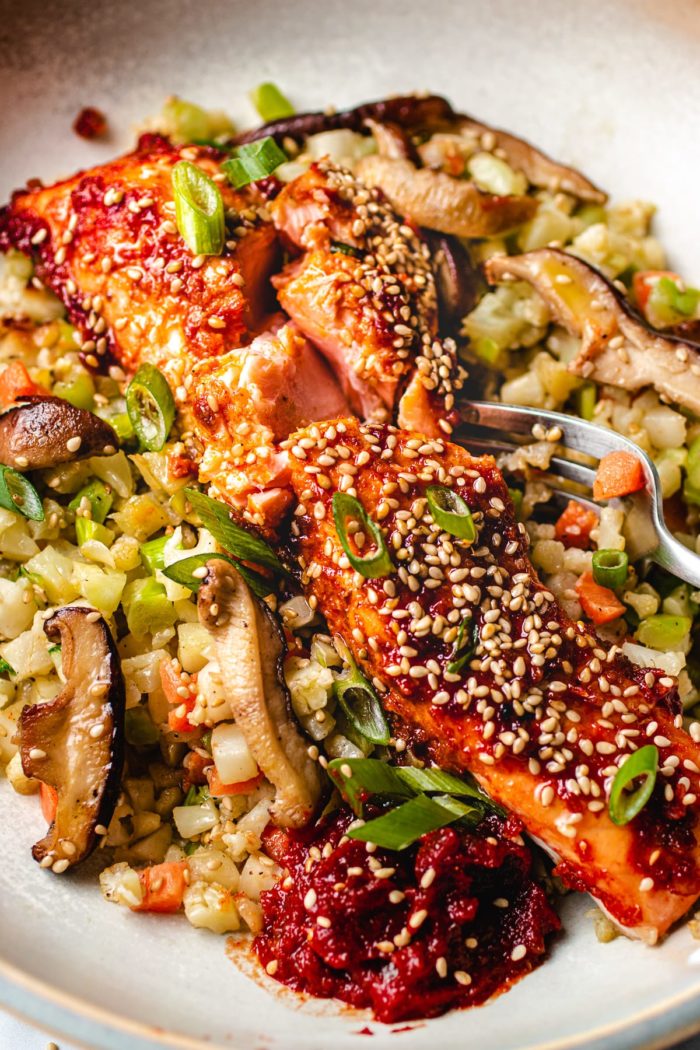
Table of Contents
- Whole30 Salmon (Paleo, Gluten-free)
- Why is this gochujang-glazed Asian salmon recipe so good?
- How to make Baked Whole30 Salmon with Gochujang Glaze (even if you aren’t doing Whole30)
- How long to bake salmon in the oven?
- What to serve with Paleo Whole30 Baked Salmon
- How to reheat the baked salmon?
- How to Use Gochujang? What else can you do with it?
- How long is cooked salmon good for in the fridge?
- More easy salmon Recipes
- Whole30 Salmon with Sweet Spicy Gochujang Glaze
Whole30 Salmon (Paleo, Gluten-free)
When I need a quick meal and don’t want to spend time chopping, seafood dishes are almost always my go-to. I grew up in a seaport town in the southern part of Taiwan so naturally, my family adores having fish for dinner. To be honest with you I was not fond of fish when growing up. My family, especially my dad, loves steamed whole fish with head and tail on and with bones! To him, enjoying a whole fish means more flavorful but to me, it was a hassle and I seemed to never learn how to not accidentally swallow the bones.
You have no idea how happy I am after I moved to the States and realize most of the folks here, like me, prefer fillets over a whole fish. 🙂 Fish fillets are easy to prepare and I think most of us can agree that salmon is packed with good fat and nutrition we should include seafood in our meal rotations at least once per week!
This gochujang glazed Paleo Whole30 salmon takes fewer than 20 minutes (with 10-14 minutes of baking time) and tastes as it came from a restaurant! Your salmon will have a sweet caramelized glaze on the outside and moist on the inside, and you’ll have only one pan to wash in the end!
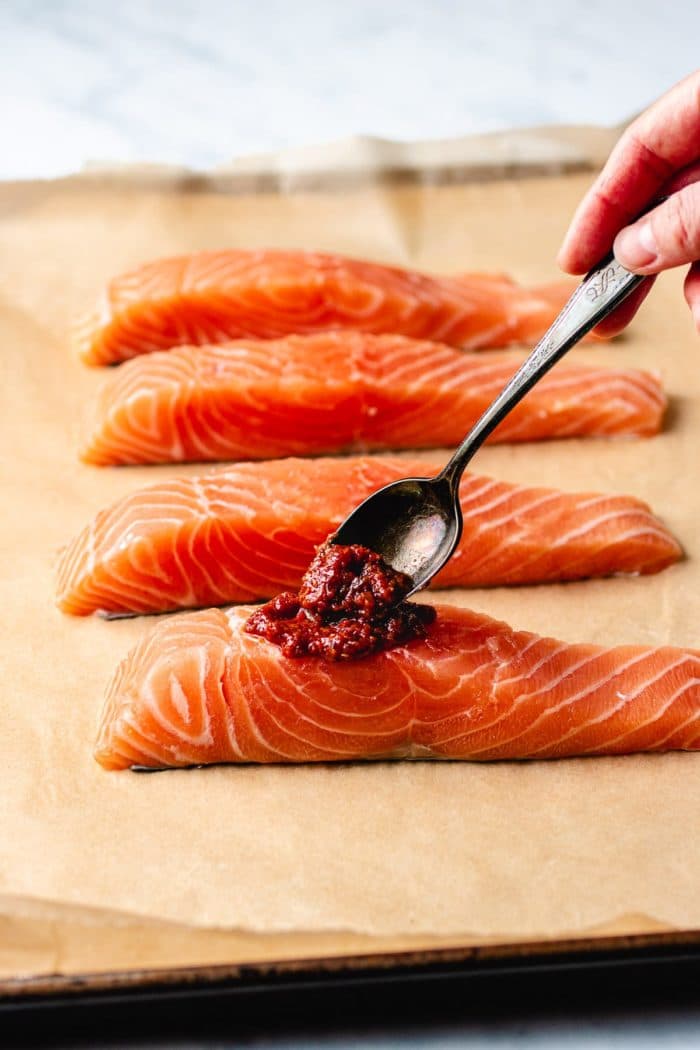
Save This Recipe
Why is this gochujang-glazed Asian salmon recipe so good?
My Whole30 and Paleo gochujang paste (Korean chili paste) is made with pitted dates, apple cider vinegar, tomato paste, Korean red chili pepper (gochugaru) or cayenne pepper, and garlic onion powder. The gochujang glaze is blended with garlic, ginger, and coconut aminos for extra flavor. It’s sweet, salty, gingery, garlicky, and a little sweet.
The best part is – there’s no marinating required! All you need is pat dry the salmon fillets and lightly coat the gochujang sauce over the fish and bake! See? You don’t need any fancy ingredients to make the best-baked salmon!
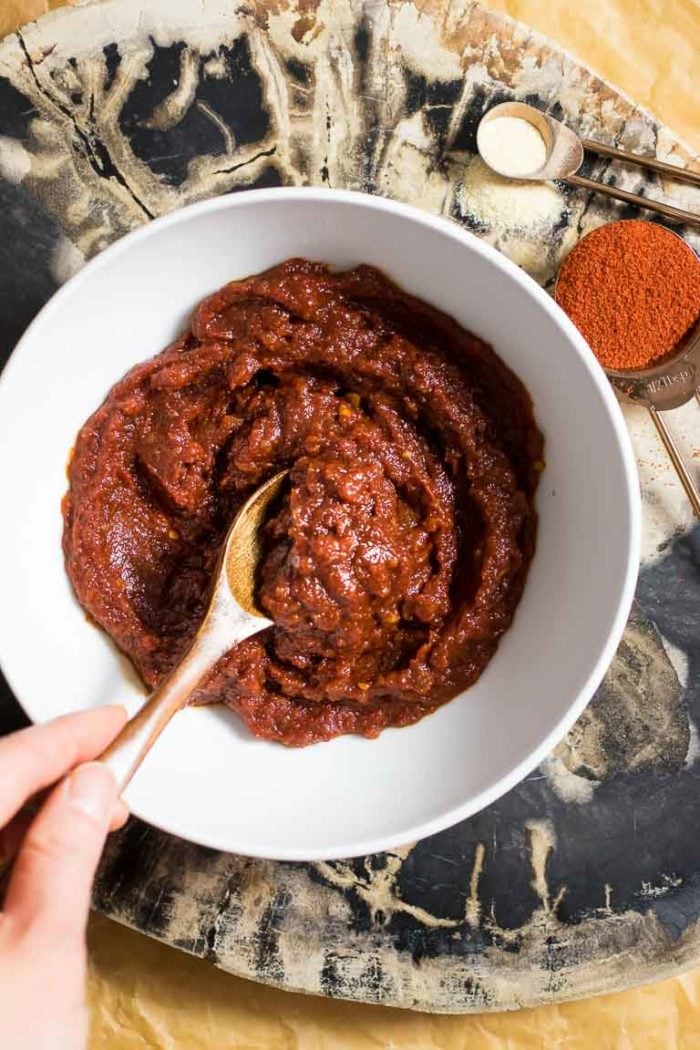
How to make Baked Whole30 Salmon with Gochujang Glaze (even if you aren’t doing Whole30)
This baked Asian salmon recipe is super simple and great for home cooks at all levels. The flavor is sweet (from dates) and a little spicy (from chili powder). It’s like a mini upgrade to your favorite BBQ sauce with a Korean flair.
- Purchase salmon fillets with or without the skin.
- Wild-caught salmon generally has less fat than farm-raised salmon. If you use wild-caught, reduce the bake time as it’s prone to becoming dry and overcooked.
- Run your finger through the fillets to check if there are any tiny bones remaining. I use this fish bone tweezers.
- Pat dry then brush with gochujang glaze all over the fillets (top and sides).
- Bake in the oven over a lined baking sheet pan until the fillets are butter soft and flaky
How long to bake salmon in the oven?
One thing to remember is to not over-bake it. I personally prefer medium-done salmon.
- The bake time depends on the thickness. For every 1-inch thick fillet, you’ll need about 10 minutes of baking time. For example, for 1.5-inch thick fillets, you’ll need about 14-15 minutes of baking time, depending on the temperature of the oven.
- Wild salmon contains less fat than farm-raised so you’ll want to watch the salmon more closely as it’s easier for it to dry out in the oven.
- You can use a fork to gently flake the layers of flesh in the thickest part of the fish. The salmon should be opaque and easy to flake with a fork. For people who prefer medium-rare, look for a slightly pink/rare center.
- If you want to be more exact, use an instant-read thermometer and insert it into the thickest part of the salmon. 130F will give you a slightly rare center, 140F for medium, 145F is the USDA recommended minimum temperature, and above 145F the fish is overdone and will taste dry.
- After you remove the salmon from the oven, the fish will continue to “cook” as it rests. To prevent it from being overdone, remove the salmon early (for example: between 135-140F) and cover the salmon with foil, and let it rest for about 5 minutes. The temperature will come up to 145F.
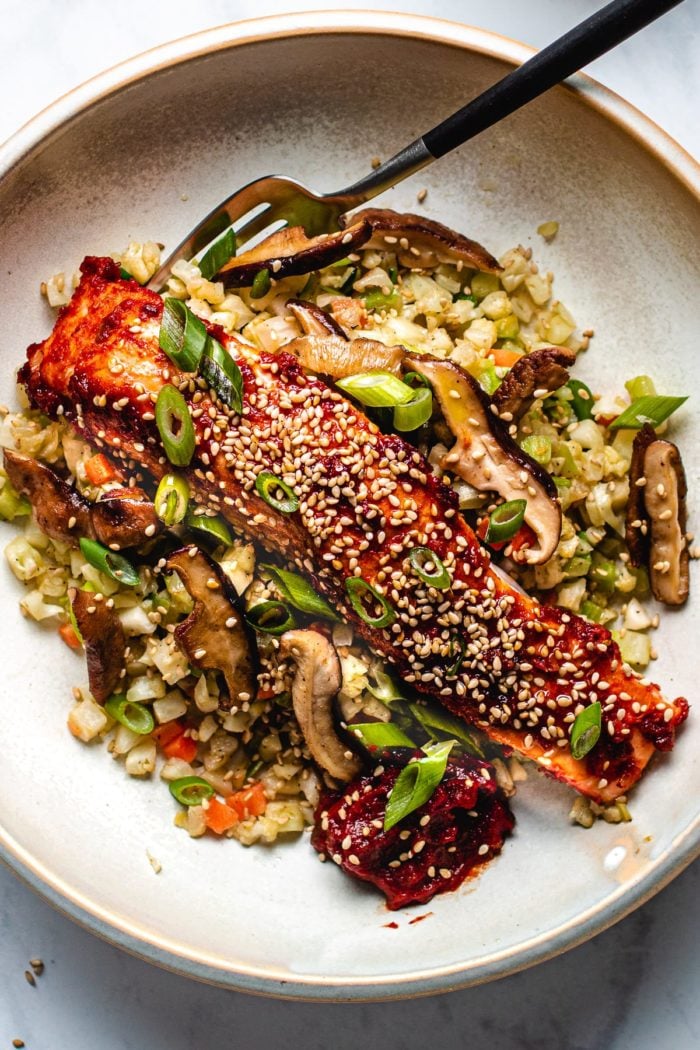
What to serve with Paleo Whole30 Baked Salmon
I serve this Asian-inspired salmon recipe with cauliflower or broccoli fried rice with sauteed shiitake. If you aren’t a fan of cauliflower fried rice, try my Keto fried rice with garlic chips. It’s the closest thing to real fried rice but without the carbs.
You can also pair the Paleo salmon with sauteed cabbage, Chinese broccoli with oyster sauce, mung bean sprouts salad, snow pea leaves stir-fry, or baby bok choy dim sum. The possibilities are endless!
For an extra hearty meal combo, my Gochujang pasta is made with the same sauce!
How to reheat the baked salmon?
I recommend reheating the baked salmon in individual portions and without the skin. You can reheat it over the stovetop, which will give you a lightly caramelized crust or reheat it in the microwave, which will keep the fish moist and not dry, or use a toaster oven.
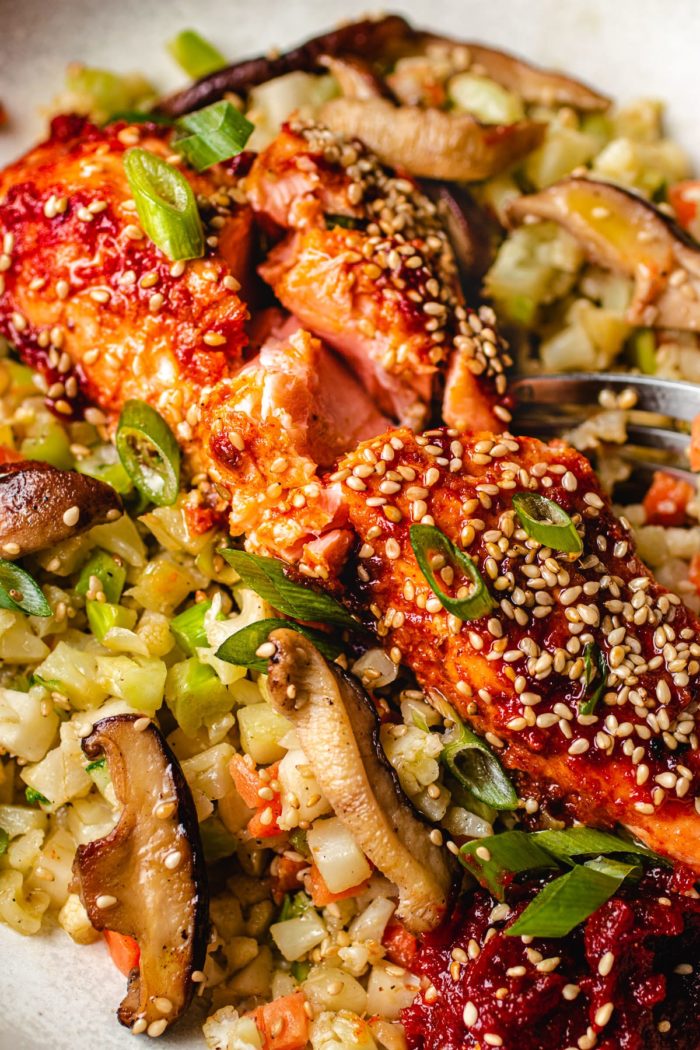
How to Use Gochujang? What else can you do with it?
Gochujang is used in many dishes. For example: bibimbap (Korean rice bowls), in soups, stews, and marinated dishes. It’s also a great dipping sauce for vegetable platters. You can use the same sauce for chicken, beef, pork, or any plant-based proteins. I like to mix the paste with kimchi cauliflower fried rice. The paste makes the dish taste more authentic and more flavorful. You can store the extra gochujang sauce in the fridge for up to 3 weeks.
How long is cooked salmon good for in the fridge?
I recommend eating the cooked salmon within 2 days. You can reheat it, with the skin removed, in a microwave or over a stovetop.
More easy salmon Recipes
- One pot salmon and rice
- Whole30 Salmon Cakes
- Air fryer salmon teriyaki
- Glazed Salmon Fillet Recipe with “Soy” Ginger Sauce
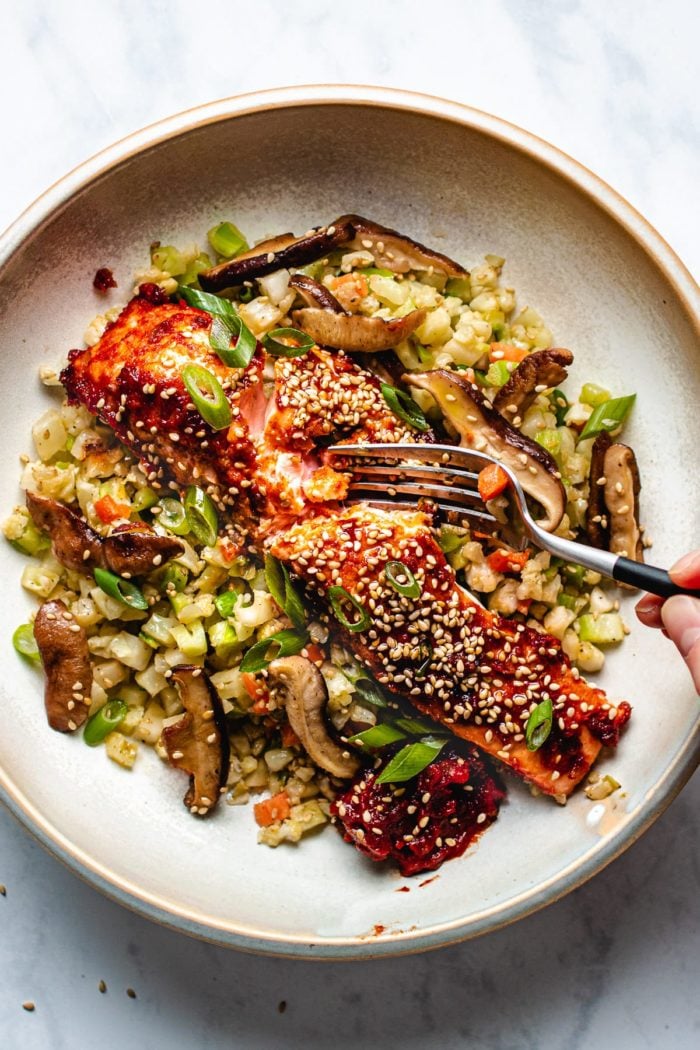
Whole30 Salmon with Sweet Spicy Gochujang Glaze
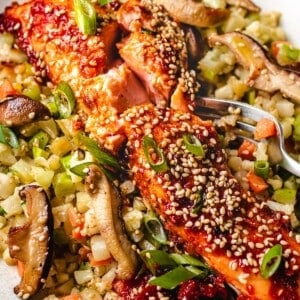
Ingredients
Gochujang-glaze:
- 3 tbsp Paleo Gochujang
- 2.5 tsp grated ginger
- 0.3 oz. garlic crushed, about 2 small cloves
- 1 tbsp coconut aminos
- 1 tsp toasted sesame oil
Salmon:
- 4 (5.25 oz) Salmon fillets about 1 ¼-inch thickness, skin-on or off
- 1-2 bulbs scallions diced
- Toasted sesame seeds sprinkle, optional
Pairing suggestions:
- Cauliflower or broccoli fried rice
- 3.5 oz. Fresh shiitake sauteed, see notes
Instructions
- Preheat oven to 400F.
- Follow the paleo gochujang recipe instructions to blend until smooth. Stir-in ginger, garlic, coconut aminos, and sesame oil. Mix well and set aside in a bowl.
- Run your fingers through the salmon to check if there are remaining bones.
- In a large baking sheet pan, line with parchment paper. Pat dry the fillets and place them skin side down and with some space in-between.
- Use the back of a spoon to smother each fillet with about 1 tbsp gochujang glaze over the top and on both sides.
- Bake about 10 to 14 minutes total. Check after 10 minutes.
- The bake time will depend on the thickness of the fish. You can use a fork to gently flake the layers of flesh in the thickest part of the fish. The salmon should be opaque and easy to flake with a fork. For people who prefer medium-rare, look for a slightly pink/rare center.
- Sprinkle with scallion and sesame seeds, if using.
- Serve hot or in room temperature with cauliflower fried rice and sauteed shiitake.
Notes
- I recommend eating the cooked salmon within 2 days. You can reheat it, without the skin, in a microwave or over a stovetop.
One thing to remember is to not over bake it.
- The bake time depends on the thickness. For every 1-inch thick fillet, you’ll need about 10 minutes of baking time. For example, for 1.5-inch thick fillets, you’ll need about 14-15 minutes of baking time, depending on the temperature of the oven.
- Wild salmon contains less fat than farm-raised so you’ll want to watch the salmon more closely as it’s easier for it to dry out in the oven.
- You can use a fork to gently flake the layers of flesh in the thickest part of the fish. The salmon should be opaque and easy to flake with a fork. For people who prefer medium-rare, look for a slightly pink/rare center.
- If you want to be more exact, use an instant-read thermometer and insert it into the thickest part of the salmon. 130F will give you a slightly rare center, 140F for medium, 145F is the USDA recommended minimum temperature, above 145F the fish is overdone and will taste dry.
- After you remove the salmon from the oven, the fish will continue to “cook” as it rests. To prevent it from overdone, remove the salmon early (for example: between 135-140F) and cover the salmon with foil and let it rest for about 5 minutes. The temperature will come up to 145F.
Nutrition
Nutrition information is automatically calculated, so should only be used as an approximation.
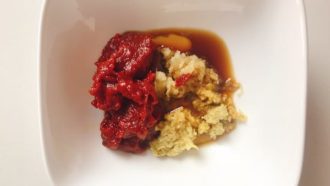
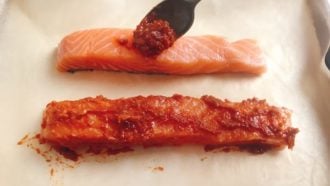
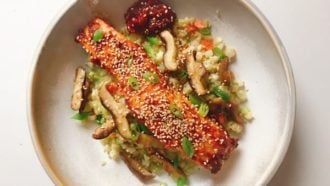
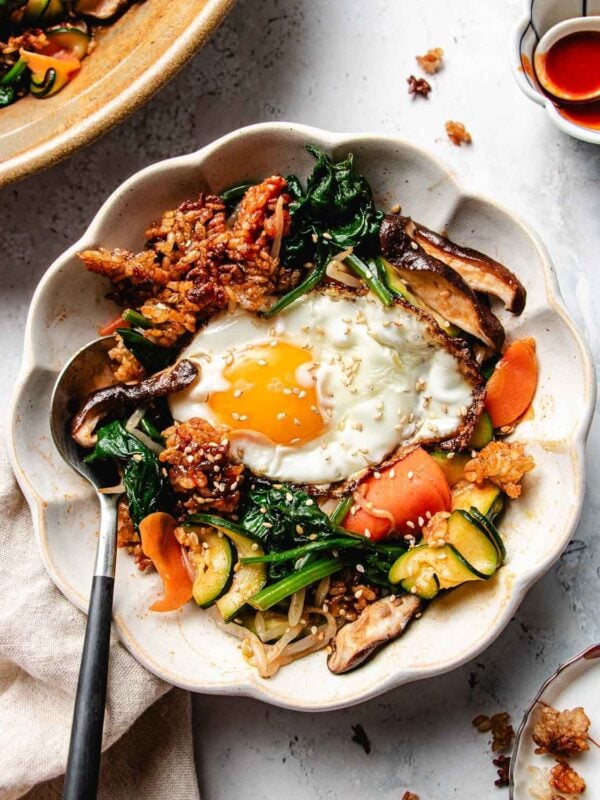
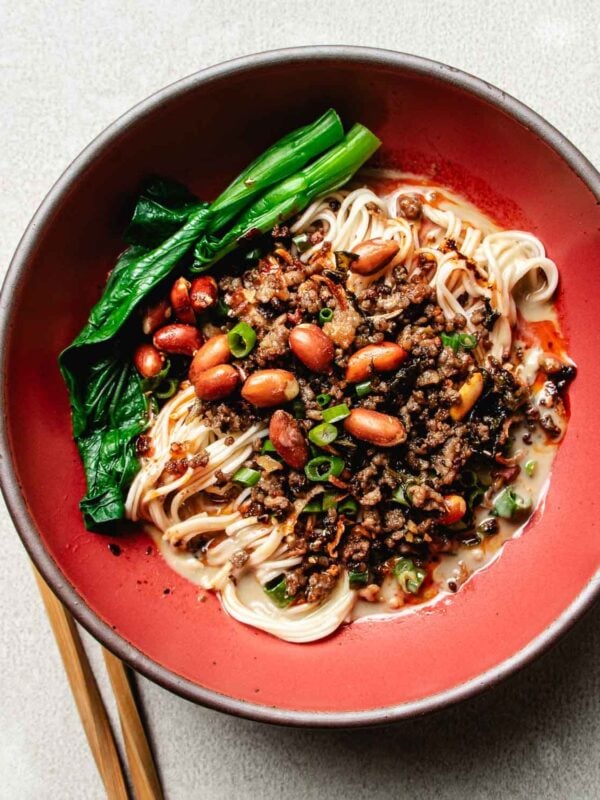
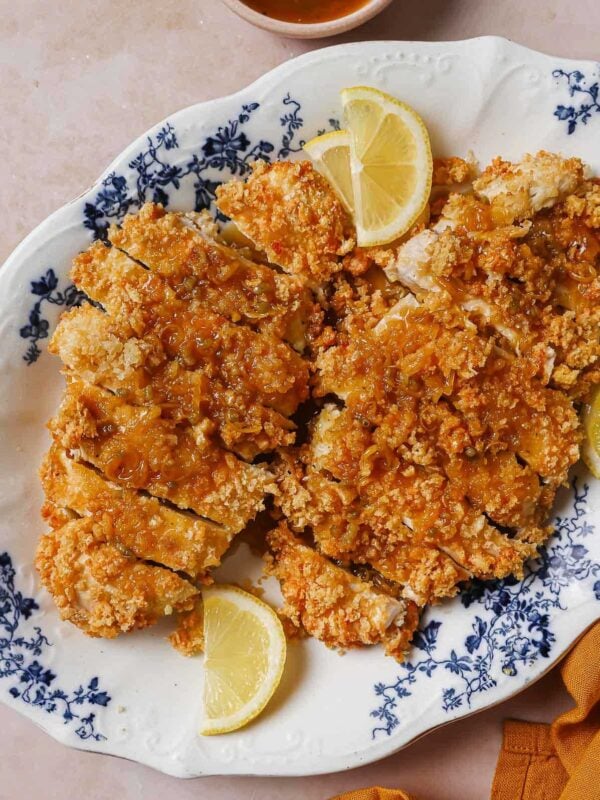
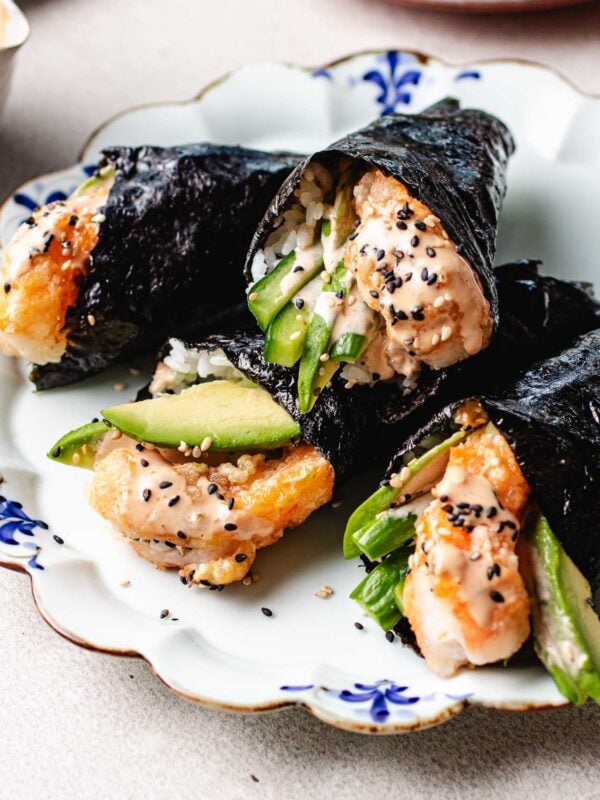
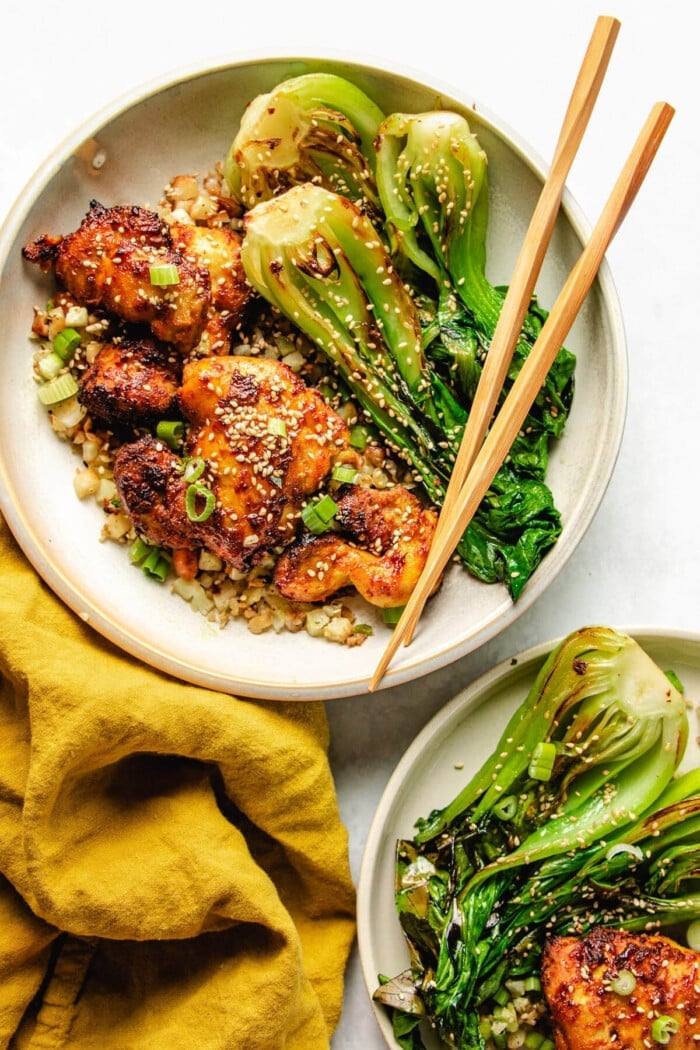








This glaze is amazing! Will be on repeat! Yum!
this is so incredible.
DELICIOUS. I ended up putting the paste on two pieces of salmon instead of four and it was incredible. I made the cauliflower rice with just some onions/garlic. So good!! I also miss Taiwan. The food was amazing there. Are there other dishes we can make with this yummy chili paste?
Hi Joni, thank you! Yes I linked them in the post and I’ll share more recipes, using the homemade gochujang paste! Just in case, the kimchi cauli fried rice recipe uses the gochujang paste, too. It adds extra depth to the fried “rice” and made it taste more authentic in my opinion. 🙂 https://iheartumami.com/kimchi-cauliflower-fried-rice/
This was delicious as written. I had some leftover glaze and put it on boneless skinless chicken thighs and cooked them in the air fryer. It was AMAZING! Crispy and lightly charred, slightly spicy and sweet. So good!
Thank you! So happy to hear!